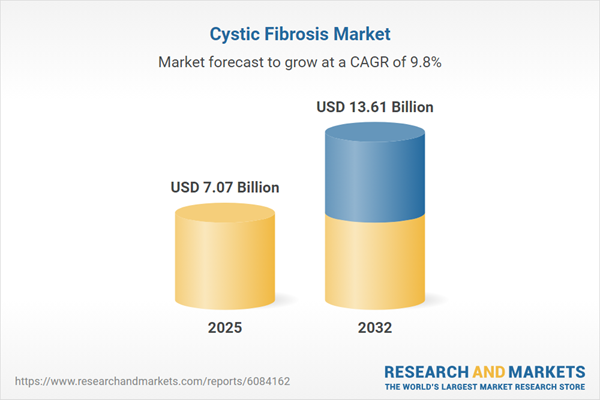Speak directly to the analyst to clarify any post sales queries you may have.
The cystic fibrosis market is evolving rapidly as next-generation therapies, digital health integration, and strategic market adaptations converge, presenting fresh opportunities and uncertainties for industry leaders navigating this demanding segment.
Market Snapshot
The Cystic Fibrosis Market grew from USD 6.44 billion in 2024 to USD 7.07 billion in 2025. It is expected to continue growing at a CAGR of 9.80%, reaching USD 13.61 billion by 2032. The current landscape reflects robust growth driven by breakthroughs in CFTR modulator therapies and adapting delivery models that increasingly support remote monitoring and home-based management.
Scope & Segmentation
This report provides in-depth segmentation and trend analysis relevant to the cystic fibrosis market. Key segmentations include:
- Product Type: Anti-inflammatories, Antibiotics, CFTR Modulator Therapies (Elexacaftor-Tezacaftor-Ivacaftor, Ivacaftor, Lumacaftor-Ivacaftor, Tezacaftor-Ivacaftor), Mucolytics, Pancreatic Enzymes
- Route of Administration: Inhalation, Intravenous, Oral
- End User: Home Healthcare, Hospitals, Specialty Clinics
- Distribution Channel: Offline Pharmacy (Hospital Pharmacy, Retail Pharmacy), Online Pharmacy
- Regional Coverage: Americas (North America: United States, Canada, Mexico; Latin America: Brazil, Argentina, Chile, Colombia, Peru), Europe, Middle East & Africa (Europe: United Kingdom, Germany, France, Russia, Italy, Spain, Netherlands, Sweden, Poland, Switzerland; Middle East: United Arab Emirates, Saudi Arabia, Qatar, Turkey, Israel; Africa: South Africa, Nigeria, Egypt, Kenya), Asia-Pacific (China, India, Japan, Australia, South Korea, Indonesia, Thailand, Malaysia, Singapore, Taiwan)
- Key Companies: Vertex Pharmaceuticals Incorporated, F. Hoffmann-La Roche Ltd, Novartis AG, Gilead Sciences, Inc., Teva Pharmaceutical Industries Ltd, Viatris Inc., Sun Pharmaceutical Industries Ltd, Cipla Limited, Lupin Limited, AbbVie
Key Takeaways
- Precision therapies and CFTR modulators are reshaping therapeutic standards, prompting shifts from symptom-centric management to genotype-directed treatment paradigms.
- Home-based care and digital health solutions are growing in adoption, enabling flexible, patient-driven management and supporting medication adherence in diverse geographies.
- Stakeholders face ongoing challenges with access variability, infrastructure gaps, and payer-driven decision frameworks that impact therapeutic uptake and commercial strategy.
- Strategic supplier partnerships and investments in localized manufacturing strengthen supply chain resilience, especially as regulatory and policy shifts affect procurement models.
- Clinical trials and real-world evidence are increasingly critical for product differentiation, supporting payer negotiations, and aligning value propositions to evolving reimbursement landscapes.
- Portfolio expansion strategies are leveraging integrated platforms and collaborations to transition molecular innovation into commercial impact across regional markets.
Tariff Impact
Recent United States tariff measures have influenced supply chain decisions throughout the cystic fibrosis therapeutics sector. Tariffs on essential components have caused manufacturers to re-evaluate sourcing and production strategies, prompting greater investment in regional supply chains and adaptive inventory management. These adjustments are shaping pricing considerations and driving the need for flexible commercial agreements to protect continuity amid changing trade conditions.
Methodology & Data Sources
This report is built on a systematic review of scientific literature, regulatory data, and structured expert interviews. Data triangulation and evidence synthesis ensure a balanced perspective. Ongoing validation focuses on recency and practical relevance for senior decision-makers.
Why This Report Matters
- Delivers actionable segmentation and market entry intelligence tailored to evolving clinical and commercial realities.
- Identifies priority areas for investment in both patient-centric delivery models and resilient supply chain architectures.
- Supports evidence-based strategic planning by highlighting how innovation, regulation, and policy combine to shape outcomes in mature and emerging markets.
Conclusion
Coordinated efforts in evidence development, operational flexibility, and patient-focused strategy are crucial for translating therapeutic innovation into measurable value. Informed leadership and adaptive planning will sustain progress in cystic fibrosis care and market performance.
Table of Contents
3. Executive Summary
4. Market Overview
7. Cumulative Impact of Artificial Intelligence 2025
Companies Mentioned
The companies profiled in this Cystic Fibrosis market report include:- Vertex Pharmaceuticals Incorporated
- F. Hoffmann-La Roche Ltd
- Novartis AG
- Gilead Sciences, Inc.
- Teva Pharmaceutical Industries Ltd
- Viatris Inc.
- Sun Pharmaceutical Industries Ltd
- Cipla Limited
- Lupin Limited
- AbbVie
Table Information
| Report Attribute | Details |
|---|---|
| No. of Pages | 182 |
| Published | October 2025 |
| Forecast Period | 2025 - 2032 |
| Estimated Market Value ( USD | $ 7.07 Billion |
| Forecasted Market Value ( USD | $ 13.61 Billion |
| Compound Annual Growth Rate | 9.8% |
| Regions Covered | Global |
| No. of Companies Mentioned | 11 |









